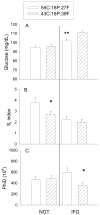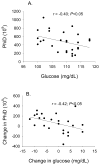A higher-carbohydrate, lower-fat diet reduces fasting glucose concentration and improves β-cell function in individuals with impaired fasting glucose
- PMID: 21944267
- PMCID: PMC3248972
- DOI: 10.1016/j.metabol.2011.07.011
A higher-carbohydrate, lower-fat diet reduces fasting glucose concentration and improves β-cell function in individuals with impaired fasting glucose
Abstract
The objective was to examine the effects of diet macronutrient composition on insulin sensitivity, fasting glucose, and β-cell response to glucose. Participants were 42 normal glucose-tolerant (NGT; fasting glucose <100 mg/dL) and 27 impaired fasting glucose (IFG), healthy, overweight/obese (body mass index, 32.5 ± 4.2 kg/m(2)) men and women. For 8 weeks, participants were provided with eucaloric diets, either higher carbohydrate/lower fat (55% carbohydrate, 18% protein, 27% fat) or lower carbohydrate/higher fat (43:18:39). Insulin sensitivity and β-cell response to glucose (basal, dynamic [PhiD], and static) were calculated by mathematical modeling using glucose, insulin, and C-peptide data obtained during a liquid meal tolerance test. After 8 weeks, NGT on the higher-carbohydrate/lower-fat diet had higher insulin sensitivity than NGT on the lower-carbohydrate/higher fat diet; this pattern was not observed among IFG. After 8 weeks, IFG on the higher-carbohydrate/lower-fat diet had lower fasting glucose and higher PhiD than IFG on the lower-carbohydrate/higher-fat diet; this pattern was not observed among NGT. Within IFG, fasting glucose at baseline and the change in fasting glucose over the intervention were inversely associated with baseline PhiD (-0.40, P < .05) and the change in PhiD (-0.42, P < .05), respectively. Eight weeks of a higher-carbohydrate/lower-fat diet resulted in higher insulin sensitivity in healthy, NGT, overweight/obese individuals, and lower fasting glucose and greater glucose-stimulated insulin secretion in individuals with IFG. If confirmed, these results may have an impact on dietary recommendations for overweight individuals with and without IFG.
Copyright © 2012 Elsevier Inc. All rights reserved.
Figures


References
-
- Cowie CC, Rust KF, Byrd-Holt DD, et al. Prevalence of diabetes and impaired fasting glucose in adults in the U.S. population. Diabetes Care. 2006;29:1263–1268. - PubMed
-
- Wild S, Roglic G, Green A, et al. Global prevalence of diabetes. Diabetes Care. 2004;27:1047–1053. - PubMed
-
- DeFronzo RA. Pathogenesis of type 2 diabetes mellitus. Med Clin North Am. 2004;88:787–835. - PubMed
-
- Rana JS, Li TY, Manson JE, et al. Adiposity compared with physical inactivity and risk of type 2 diabetes in women. Diabetes Care. 2007;30:53–58. - PubMed
-
- Wilson PWF, Meigs JB, Sullivan L, et al. Prediction of incident diabetes mellitus in middle-aged adults: The Framingham Offspring Study. Arch Intern Med. 2007;167:1068–1074. - PubMed
Publication types
MeSH terms
Substances
Grants and funding
LinkOut - more resources
Full Text Sources
Medical

